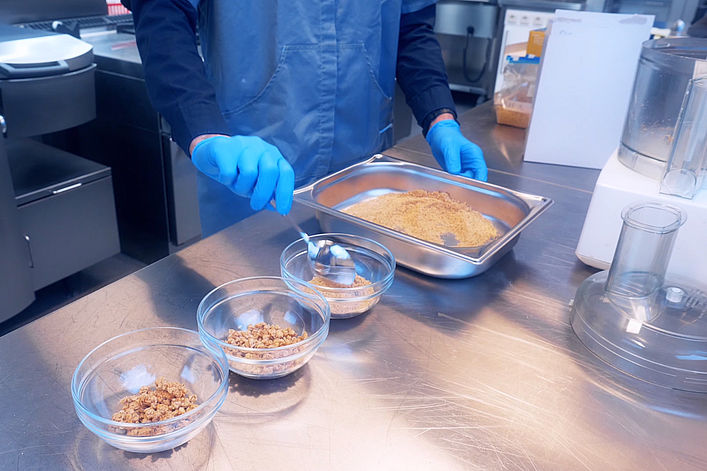New ESN publication in FQP: Texture & Eating Behaviour
Food designed for different eating styles could prevent overeating
A texture-liking-intake study from a group of ESN researchers demonstrates that textural changes in a food product may lead to different reactions among consumers.

The research team changed the viscosity of the yogurts and added different sizes of granola pieces.
It depends on the eating behaviour and the textural preferences of the consumers whether the change could lead to the intended effect of preventing overeating. The results support the idea of developing more individualized food products that cater to different segments of consumers.
It sounds so easy: Add more texture to a food – which, for example, will make it more viscose or harder to chew – and people may eat less and lose weight. After all, studies have shown that more texture in a food affords more oral processing, slows down the eating rate which goes along with eating less and therefore taking in less calories. But consumers – or people in general – are not that simple, and importantly, people differ from one another.
Texture, bites, and video
To understand how texture, liking, and food intake interact, Paula Varela (ESN member Nofima, Norway), Carol Mosca (ESN researcher from 20018-2019 at ESN member Wageningen University, The Netherlands), Quoc Cuong Nguyen (Ho Chi Minh City University of Technology, Vietnam), Jean A. McEwan (ESN research manager, Jean A McEwan Consulting), and Ingunn Berget (Nofima, Norway) analyzed data from an ESN-funded texture study which was conducted by Carol Mosca in 2018.

Carol Mosca prepares the different yogurts.
The question the team asked was: In which way does a change in the texture of a yogurt influence how much consumers eat and how is that related to their liking of the yogurt. 103 volunteers came to the sensory lab at the University of Wageningen and sampled six different yogurts. The samples differed in viscosity and in the size of the granola pieces that were added to the yogurt. The research team analyzed the eating behavior of the consumers via video camera and collected data on the number of chews, the eating rate, and the amount eaten. The data analysis showed that the volunteers could be divided into three different groups, according to their reaction to textural changes in the yogurt.
When liking and intake diverge
The “small eaters” ate more yogurt when the granola pieces were small. The second group ate less of the yogurt with small pieces when the yogurt was thick (“thick sensitive eaters”), the third group ate less of the yogurt with small pieces regardless of whether the yogurt was thick or thin (“small rejectors”).
Surprisingly, the “small eaters” ate faster and ate more of the yogurt with the small pieces even though they didn´t even like the produ ct. A driver of liking for one person or consumer segment could be the preventer of liking for others. It is possible, the researchers argue, that physiological characteristics such as tongue movement, saliva composition, oral sensitivity, and receptor density influence the segment in which a consumer falls.

In the sensory lab at the University of Wageningen. The partipants could eat as much yogurt as they liked.
After personalized medicine comes personalized food
“Thus, manipulations on textural properties may reduce the intake for some consumers, but not for all”, says lead author Paula Varela. Therefore, the idea that a tweaking of the texture could lead to less food intake does not apply universally to all consumers. Rather, the results point to the need for a more personalized approach in the formulation of food that can reduce overeating.
It might not be possible to design a tasty yogurt for each individual, but it may be possible to offer consumers different options that match their eating style. To do so, food producers need to come to a better understanding of the texture sensitivities of the consumers.
Publication: Varela P, Mosca A, Nguyen Q, McEwan J, Berget I. Individual differences underlying food intake and liking in semisolid foods. Food Quality and Preference, Volume 87, January 2021, 104023 https://www.sciencedirect.com/science/article/pii/S0950329320302925
- ---
photos: Rob Gossens (taken from a video)